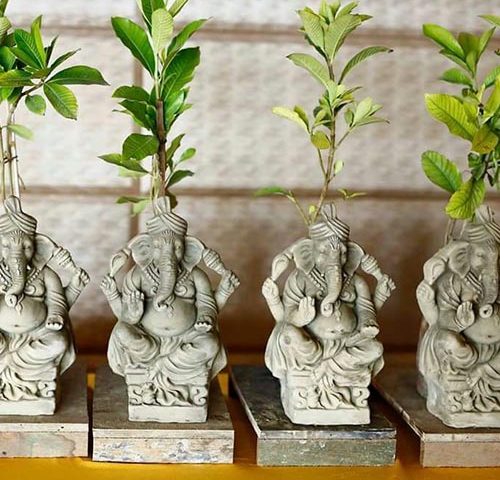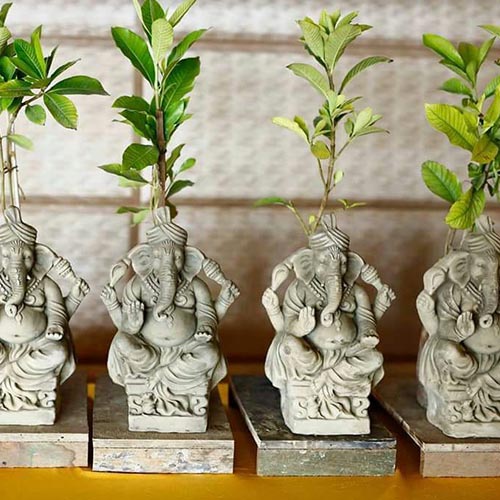I remember the excitement in my childhood of waking up on Ganesh Chathurthi morning and rushing to the local market to bring a freshly-made Ganesha idol home. A couple of us kids would ride with my father in a Lambretta scooter, wait patiently for the potter to make a clay idol in a mould, set his beady eyes, and hand it over it us in wrapped in a leaf. There was much fanfare in selecting the umbrella made of a simple stick and colourful thread.
Once set at the altar, the puja would begin with friends and relatives in attendance. Puja complete, we would stuff ourselves silly with delicacies mom made and then spend the afternoon in food coma. Come evening, we would visit the few pandals in the neighbourhood. Visarjan (days earmarked for immersion) meant that we took the idol to be immersed in the sea and that was that.
This is very different from my experience now – I just go to the market, select a small, yet colourfully decorated idol and an umbrella made of plastic or shiny gold thread. While the eating and meeting family remains almost the same, almost all festivals have become bigger and brighter recently. This is most true for festivals like Ganesha chaturthi, durga puja, and diwali. People vie with each other for the bigger, brighter, and more colourful idols to probably to show they are more devout.
Sample this – in Hyderabad, 4,000 metric tons of garbage is produced every day. During Ganesh festival alone 3,000 more metric tonnes of garbage is added every single day. This amounts to about 7,200 metric tonnes of garbage which needs 3,000 labourers deployed on three shifts using 94,000 plastic bags to collect garbage. Just imagine the money spent on infrastructure, earth movers, and trips made by sanitation trucks every day!
With the widespread immersion of Ganesha idols, a good number of lakes in India are increasingly polluted. This issue is becoming more and more important to environment particularly with respect to environment, human health, and flora and fauna present in the river. It is ironic that after praying to Ganesha, we cause such terrible damage to the water bodies by immersing these toxic, painted idols and killing aquatic life!
Let’s take a quick look at the most damaging consequences of our favourite festival:
Non-biodegradable idols
The most damage comes from idols made of Plaster of Paris (PoP) that may take several months or years to fully dissolve. In addition, the chemical paints used to decorate the idols contain heavy metals like mercury, cadmium and lead (neurotoxin and nephrotoxin), which seep into the water as the idol dissolves. These metals are bio-accumulative, which means that they enter marine life, get passed up the food chain, and end up in our food.
In some cases, the idols are painted with bright synthetic colours or lead oxide mixed with oils which are toxic. The brighter the colour, the greater the toxicity. Red, blue, orange and green colours are known to have higher content of mercury, zinc oxide, chromium and lead. In fact, a single drop of mercury on a person’s skin can be fatal; a drop in a 20-acre lake can make the fish poisonous to the birds and animals, and people who eat them.
Decorations at the altar
Another potential threat is in the use of non-biodegradable decorations made of wood, stone, grass, jute, thermacol, plastic, flowers, germinated seeds, coconuts, leaves etc. The problem is multiplied when these decorations are immersed along with the idol. Such material may contain organic and inorganic pollutants including oil, grease, plastics, and suspended solids that impact the water quality as they decay.
Visarjan days
These days, visarjan means huge trucks and tempos to transport the idols for immersion. Typically, these processions are taken by members of the community playing loud music, and sometimes include bursting firecrackers. Almost all lakes on such days look like a war zone, with people milling all around, with hydraulic cranes used for lowering the Ganesha idols for immersion. A delayed, but glaring issue is that these huge idols block the natural flow of water causing stagnation, further causing more harm to the environment.
So what is the solution to overcoming the above problems?
- Firstly, buy an eco-friendly clay or Plant a Ganesha Alternatively, you can use idols made of recycled waste paper, natural clay, natural fibres, brass, or stone.
- If you buy a Plant a Ganesha idol, do a symbolic immersion if possible.
- Limit the size and number of Ganesh idols in your community, focussing more on purity of the festival.
- Use natural biodegradable colours for Rangoli (turmeric, henna, and rice powder).
- Use paper flowers or natural flowers for decorations.
- Collect the biodegradable decorations and compost them. You can use these to grown your garden in the future.
- Ban plastic in the place of worship or even to carry offerings. You can use cloth bags instead.
- Avoid the use of thermocol and plastic in decorations.
- Minimise noise and air pollution.
The Plant a Ganesha idol is brought to you by Live the Lakes initiative of SAHE. Please watch this video to know about how you can make this wonderful Ganesha at home! Celebrate the festival with consciousness to the environment!




